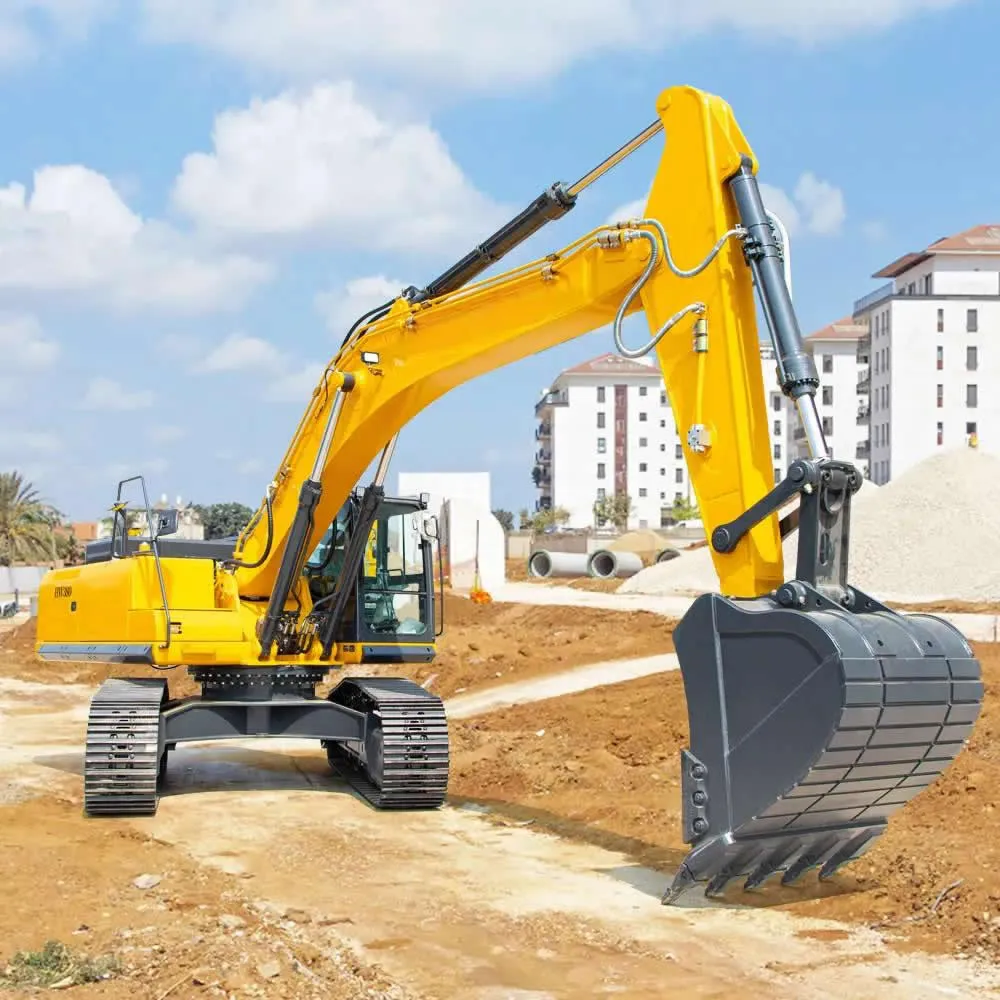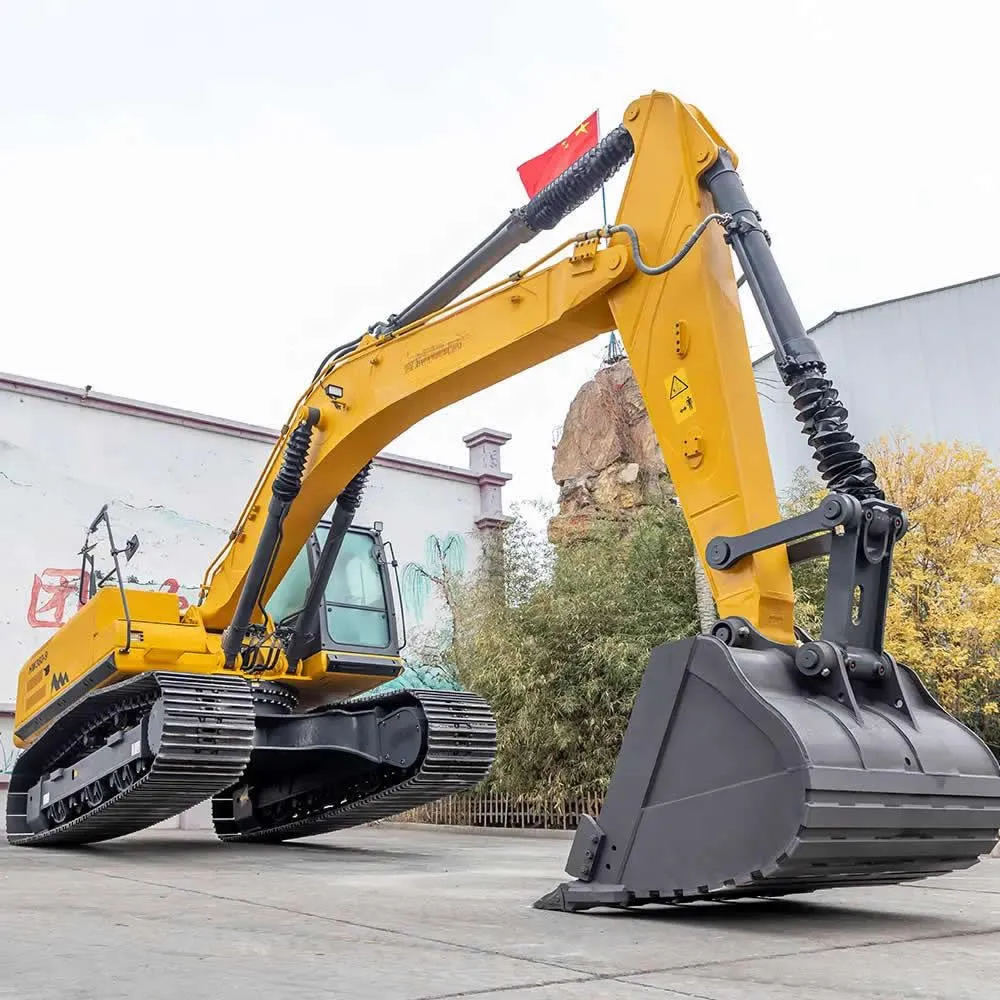Large excavators operate in industrial and mining environments, such as mines, open-pit quarries, and infrastructure earthmoving, often running continuously for hours or even tens of hours. Under prolonged operation, fatigue accumulates in various systems, wear accelerates, and potential hazards arise. To ensure equipment reliability, safety, and economic lifespan, a systematic routine inspection immediately after operation is crucial. This article analyzes key inspection items for large excavators after long-term operation from a professional perspective and provides practical operational suggestions for on-site maintenance management and work teams.

1.1 Why Perform Post-Operation Inspections?
During long-term operation, the excavator's engine reaches high temperatures, the hydraulic system experiences high pressure, the chassis rails are impacted by gravel and mud, and the working devices move frequently. All of these factors place significant loads on various components, accelerate wear, and cause hidden damage. Timely inspection can:
Detect and address early symptoms such as oil leaks, cracks, and loosening, preventing sudden shutdowns or major malfunctions.
Maintain equipment efficiency, safety, and production continuity.
Extend equipment lifespan and reduce maintenance costs and downtime losses.
1.2 Basic Inspection Points
Timeliness: Inspection should be conducted as soon as possible after operation, as observation is more intuitive while the equipment is still warm.
Systematicity: Cover the engine, hydraulic system, chassis/rails, working devices, safety systems, and machine structure.
Standardization: It is recommended to use checklists, check-in records, and logs to track problem trends.
Comparison: Not only check for "problems," but also compare the condition before operation with the results of the last inspection to observe changes.
The engine is the core power source of the equipment. For diesel engines, after prolonged operation, the engine oil, cooling system, and intake system require special attention. In actual operation, immediately after the engine is stopped, touch the high-pressure fuel line and turbocharger housing to judge the incomplete combustion by temperature sensing. If the temperature of a cylinder's fuel line is significantly lower than normal, it may indicate injector blockage or insufficient cylinder pressure.
Inspection Points:
Engine Oil and Oil Filter Condition: Check if the engine oil is black, contains metal shavings, or is contaminated. Verify the oil filter is installed correctly and check for leaks.
Coolant Level and Radiator Condition: The coolant level should be within the normal range. Check the radiator and cooling fins for blockages such as dirt and debris. Inspect the fan belt for looseness or cracks.
Fuel System and Intake System: Check the fuel filter and air filter for saturation. Ensure the intake manifold is clear and the engine compartment ventilation is unobstructed. Clean the air filter housing; for heavy equipment operating in dusty environments, clean the filter element at least twice daily.
Engine Compartment and Cylinder Block Appearance: Check for obvious oil stains, cracks, loose or deformed bolts. Prolonged high loads can cause thermal stress that may loosen engine block connections.
Starting/Operating Performance: Start the engine when it is cool. Listen for a smooth engine sound, any intermittent abnormal noises, and any unusual exhaust emissions.
Professional Tip: After operation, it is recommended to let the engine idle for several minutes to allow the lubricating oil to return and the temperature to drop slightly before cleaning the work chamber and initial cleaning of the filter. Then, record information such as engine oil color, temperature, and operating hours in the machine log.
Hydraulic system failures account for more than 42% of all excavator failures. Inspection can be performed through pressure testing, seal checks, and oil quality testing. For third-generation excavators using mechatronics technology, real-time data of the hydraulic system should also be read through the monitoring panel, paying particular attention to the adjustment performance of the variable displacement pump.
Inspection Points:
Pressure Test: Connect a hydraulic tester to test the main pump output pressure. The deviation should not exceed ±5% compared to the standard parameter table.
Hydraulic Oil Level and Quality: Check the oil level under low-temperature conditions in the hydraulic system; observe whether the hydraulic oil is emulsified, discolored, or bubbly. Abnormal oil quality may indicate water contamination or excessively high temperature.
Oil pipes, hoses, joints, and seals: Inspect for oil leaks, oil stains, scratches, cracks, or twists. Observe high-pressure joints for signs of oil seepage. Hydraulic leaks are often a sign of major malfunctions.
Cylinder block, piston rod, and hinge assembly: Check the outer wall of the cylinder block for scratches, and the piston rod for rust or scratches. Check the hinge pins and bushings for looseness or lack of lubrication. These are crucial for the load-bearing capacity and precision of the working device.
Action response/operation sound: Operate the bucket, boom, and slewing mechanism, observing whether the movement is smooth, whether there are any jerks, abnormal noises, or sluggishness.
Oil filter and cooler: Check whether the hydraulic oil filter is clogged and whether the filter element is nearing its end of life. Check whether the hydraulic oil cooler is covered with dirt, which reduces heat dissipation efficiency.
Oil testing: Take a sample and observe the color of the hydraulic oil. Normally, it should be transparent white. If it is milky white or dark brown, it must be replaced immediately.
Professional Tip: After prolonged operation, the temperature and pressure of the hydraulic system may fluctuate significantly. It is recommended to observe the instrument readings after shutdown to see if they return to normal values. If the drop is slow or the oil temperature remains high for an extended period, system malfunction should be investigated first.

For tracked large excavators, the chassis system is the most susceptible to wear and tear.
Inspection Points:
Rail plates, chains, sprockets, guide wheels, load-bearing wheels: Check for cracks, severe wear, or weld failure in the track plates; check for missing or deformed sprocket teeth; check for loose guide wheels and load-bearing wheels, and abnormal rolling resistance.
Rail Tension: After prolonged operation, the rails may loosen due to thermal expansion or the entry of mud and stones. Check if the rail tension is within the manufacturer's recommended range. Loose or tight rails will accelerate wear.
Chassis Cleaning: Mud, stones, and debris can easily become trapped inside the rails and chassis, leading to increased rolling resistance and abnormal load on parts. Cleaning accumulated mud and stones is a daily necessity.
Chassis and Support Structure: Check side plates and chassis beams for cracks, abnormal deformation of welds, and loose bolts. Heavy loads and long-term operation can easily cause structural fatigue.
Travel Mechanism and Braking System: Check the travel motor, reducer, and brake discs for proper function, leaks, and rail pulling or jamming.
Professional Tip: After operation, it is recommended to park the equipment on level ground, disconnect the drive, raise the bucket to allow the rails to rest, and then conduct a chassis inspection. Avoid parking on slopes or soft ground to prevent uneven load deformation of the rails.
Modern large excavators are equipped with multiple safety devices, but it is still necessary to check the excavator's alarm devices, driving-related equipment, batteries, and lights.
Key Inspection Points:
Alarm Devices, Signal Lights, and Monitoring System: Check the reversing alarm, camera, and warning lights for proper function; check the control panel display and alarm indicators for any unresolved fault codes.
Cab and Operating System: Check the seat and seatbelt for damage; ensure the control levers, pedals, and buttons are responsive, without sticking or abnormal wear.
Battery, Cables, and Grounding System: Check the battery terminals for tightness and corrosion; inspect cable laying for damage and joints for overheating; verify the spare fuse and circuit breaker are functioning correctly.
Lights, Reflectors, and Glass: Since operating environments are often nighttime or low-light conditions, work lights, taillights, rearview mirrors, and windshield should be clean and undamaged.
Emergency Braking: Perform an emergency stop button function test at least once a month.
Safety Signs and Operation Manual: Check the external safety warning labels for integrity; ensure the operation manual and maintenance records in the cab are complete.
Professional Tip: During inspection, pay special attention to any instrument warning lights that remain illuminated for extended periods without being addressed. These "overlooked warning signs" are often precursors to major malfunctions.
Key Inspection Points:
Pin Shafts, Bearings, and Hinge Points: Check for loose pins between the bucket and boom, boom and stick, and stick and working device; check for loose lock nuts; and check for cracks or widened hinge gaps in the hinges.
Welding Points and Machine Structure: Inspect the working device, slewing platform, and frame structure for cracks, fatigue defects, loose welds, or base plate deformation.
Bolt and Nut Tightness: Vibration and repeated loads can cause bolts to loosen. Pay special attention to checking the hydraulic pump, slewing motor fixing bolts, and track tensioning device bolts.
Accessory Connections: Check the secure connections of various auxiliary devices (such as breakers, hydraulic shears, tilting hoppers, etc.) and the reliability of hydraulic connections.
Corrosion and Wear Resistance: Especially in mining or open-pit environments, steel structural components are susceptible to abrasion and corrosion. Observe for peeling of protective layers, rust, or severe abrasion.
Professional Tip: For large machines that have been operating for extended periods, it is recommended to perform ultrasonic or crack testing on structural components during a more thorough weekly inspection (if equipment permits) to identify potential fatigue cracks early.
Inspection Points and Procedures:
Cleaning: Promptly remove dirt, stones, and dust from the machine body, cooler, hydraulic lines, and rails. Cleaning not only improves heat dissipation but also exposes hidden problems.
Lubrication: Apply grease to critical components such as working device pins, slewing bearings, and rail chains, as recommended by the manufacturer. Lubrication points are particularly important after prolonged heavy operation.
Logs and Records: After completing the inspection, record: equipment number, operating hours, inspection time, problems found, completed items, and pending items. This facilitates subsequent trend analysis and maintenance planning.
Abnormal Recording and Feedback Mechanism: If any abnormalities are found (such as high oil temperature, abnormal bell sound, loose rails, etc.), report them to the maintenance department immediately and mark them "Pending Inspection" or "Scheduled" in the log.
Professional Tip: We recommend establishing an electronic inspection platform to photograph and record inspection results and maintenance progress, creating traceable data that aids in equipment reliability management.
Since our clients are primarily located in Africa, the Middle East, and Stan countries, we offer the following additional recommendations based on current mining environments:
High-Temperature, High-Dust Environments: After operations, pay special attention to whether the cooling system's heat sinks are covered in dust. We recommend installing dust covers or regularly cleaning them.
Humid/Dust Storm Environments: The risk of hydraulic oil and water emulsification is higher. Check for water content in the hydraulic oil; air filters must be replaced frequently.
Remote Mining Environments with Difficult Logistics: We strongly recommend carrying basic inspection tools and spare consumables (grease, filters, bolt kits, etc.) on-site to minimize downtime waiting for parts.
Work Team Training: Ensure operators are familiar with the above inspection points, provide verbal reports and sign off during shift handover, and cultivate the habit of "inspecting immediately after work."
Large excavators experience immense stress on their various systems after prolonged, continuous operation. From the engine, hydraulic system, chassis rails, structural components, and electrical safety systems, to lubrication, cleaning, and log recording, every inspection is fundamental to the reliable operation of the equipment. A single major overhaul is insufficient; true "long-term high efficiency" stems from meticulous inspections and timely interventions after daily operations.
In mining environments such as Africa, the Middle East, and Pakistan, harsh climates, poor site conditions, and remote maintenance resources make daily inspections particularly crucial. Strictly implementing daily inspections and cultivating an inspection culture will significantly improve equipment availability, reduce the risk of unexpected maintenance, and ensure safe production.